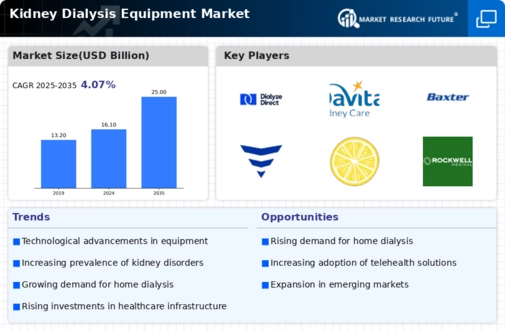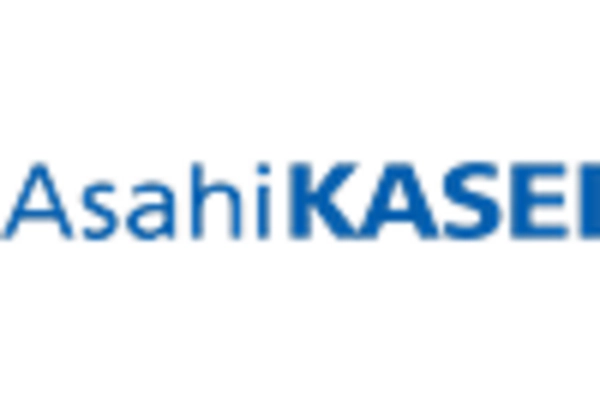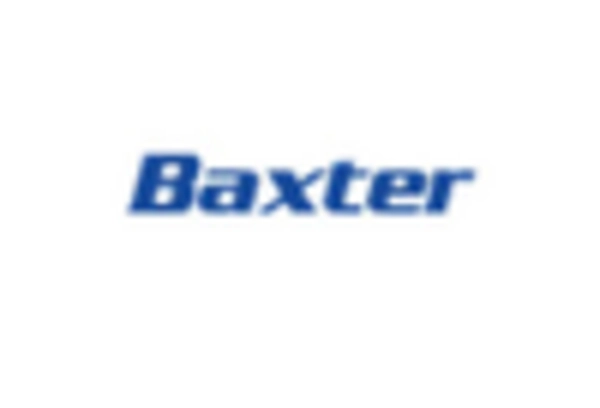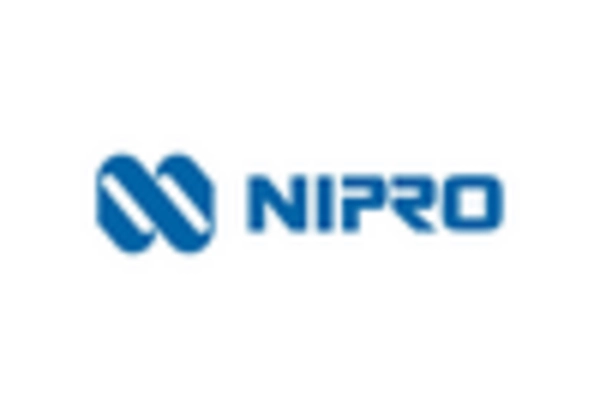Hemodialysis Machines
Peritoneal Dialysis Machines
Dialysis Consumables
Dialysis Chairs
Dialysis Monitoring Systems
Hospital
Home Care
Dialysis Centers
In-Center Dialysis
Home Hemodialysis
Automated Peritoneal Dialysis
Adult Patients
Pediatric Patients
Geriatric Patients
North America
Europe
South America
Asia Pacific
Middle East and Africa
North America Outlook (USD Billion, 2019-2035)
North America Kidney Dialysis Equipment Market by Type
Hemodialysis Machines
Peritoneal Dialysis Machines
Dialysis Consumables
Dialysis Chairs
Dialysis Monitoring Systems
North America Kidney Dialysis Equipment Market by End Use Type
Hospital
Home Care
Dialysis Centers
North America Kidney Dialysis Equipment Market by Modality Type
In-Center Dialysis
Home Hemodialysis
Automated Peritoneal Dialysis
North America Kidney Dialysis Equipment Market by Patient Demographics Type
Adult Patients
Pediatric Patients
Geriatric Patients
North America Kidney Dialysis Equipment Market by Regional Type
US
Canada
US Outlook (USD Billion, 2019-2035)
US Kidney Dialysis Equipment Market by Type
Hemodialysis Machines
Peritoneal Dialysis Machines
Dialysis Consumables
Dialysis Chairs
Dialysis Monitoring Systems
US Kidney Dialysis Equipment Market by End Use Type
Hospital
Home Care
Dialysis Centers
US Kidney Dialysis Equipment Market by Modality Type
In-Center Dialysis
Home Hemodialysis
Automated Peritoneal Dialysis
US Kidney Dialysis Equipment Market by Patient Demographics Type
Adult Patients
Pediatric Patients
Geriatric Patients
CANADA Outlook (USD Billion, 2019-2035)
CANADA Kidney Dialysis Equipment Market by Type
Hemodialysis Machines
Peritoneal Dialysis Machines
Dialysis Consumables
Dialysis Chairs
Dialysis Monitoring Systems
CANADA Kidney Dialysis Equipment Market by End Use Type
Hospital
Home Care
Dialysis Centers
CANADA Kidney Dialysis Equipment Market by Modality Type
In-Center Dialysis
Home Hemodialysis
Automated Peritoneal Dialysis
CANADA Kidney Dialysis Equipment Market by Patient Demographics Type
Adult Patients
Pediatric Patients
Geriatric Patients
Europe Outlook (USD Billion, 2019-2035)
Europe Kidney Dialysis Equipment Market by Type
Hemodialysis Machines
Peritoneal Dialysis Machines
Dialysis Consumables
Dialysis Chairs
Dialysis Monitoring Systems
Europe Kidney Dialysis Equipment Market by End Use Type
Hospital
Home Care
Dialysis Centers
Europe Kidney Dialysis Equipment Market by Modality Type
In-Center Dialysis
Home Hemodialysis
Automated Peritoneal Dialysis
Europe Kidney Dialysis Equipment Market by Patient Demographics Type
Adult Patients
Pediatric Patients
Geriatric Patients
Europe Kidney Dialysis Equipment Market by Regional Type
Germany
UK
France
Russia
Italy
Spain
Rest of Europe
GERMANY Outlook (USD Billion, 2019-2035)
GERMANY Kidney Dialysis Equipment Market by Type
Hemodialysis Machines
Peritoneal Dialysis Machines
Dialysis Consumables
Dialysis Chairs
Dialysis Monitoring Systems
GERMANY Kidney Dialysis Equipment Market by End Use Type
Hospital
Home Care
Dialysis Centers
GERMANY Kidney Dialysis Equipment Market by Modality Type
In-Center Dialysis
Home Hemodialysis
Automated Peritoneal Dialysis
GERMANY Kidney Dialysis Equipment Market by Patient Demographics Type
Adult Patients
Pediatric Patients
Geriatric Patients
UK Outlook (USD Billion, 2019-2035)
UK Kidney Dialysis Equipment Market by Type
Hemodialysis Machines
Peritoneal Dialysis Machines
Dialysis Consumables
Dialysis Chairs
Dialysis Monitoring Systems
UK Kidney Dialysis Equipment Market by End Use Type
Hospital
Home Care
Dialysis Centers
UK Kidney Dialysis Equipment Market by Modality Type
In-Center Dialysis
Home Hemodialysis
Automated Peritoneal Dialysis
UK Kidney Dialysis Equipment Market by Patient Demographics Type
Adult Patients
Pediatric Patients
Geriatric Patients
FRANCE Outlook (USD Billion, 2019-2035)
FRANCE Kidney Dialysis Equipment Market by Type
Hemodialysis Machines
Peritoneal Dialysis Machines
Dialysis Consumables
Dialysis Chairs
Dialysis Monitoring Systems
FRANCE Kidney Dialysis Equipment Market by End Use Type
Hospital
Home Care
Dialysis Centers
FRANCE Kidney Dialysis Equipment Market by Modality Type
In-Center Dialysis
Home Hemodialysis
Automated Peritoneal Dialysis
FRANCE Kidney Dialysis Equipment Market by Patient Demographics Type
Adult Patients
Pediatric Patients
Geriatric Patients
RUSSIA Outlook (USD Billion, 2019-2035)
RUSSIA Kidney Dialysis Equipment Market by Type
Hemodialysis Machines
Peritoneal Dialysis Machines
Dialysis Consumables
Dialysis Chairs
Dialysis Monitoring Systems
RUSSIA Kidney Dialysis Equipment Market by End Use Type
Hospital
Home Care
Dialysis Centers
RUSSIA Kidney Dialysis Equipment Market by Modality Type
In-Center Dialysis
Home Hemodialysis
Automated Peritoneal Dialysis
RUSSIA Kidney Dialysis Equipment Market by Patient Demographics Type
Adult Patients
Pediatric Patients
Geriatric Patients
ITALY Outlook (USD Billion, 2019-2035)
ITALY Kidney Dialysis Equipment Market by Type
Hemodialysis Machines
Peritoneal Dialysis Machines
Dialysis Consumables
Dialysis Chairs
Dialysis Monitoring Systems
ITALY Kidney Dialysis Equipment Market by End Use Type
Hospital
Home Care
Dialysis Centers
ITALY Kidney Dialysis Equipment Market by Modality Type
In-Center Dialysis
Home Hemodialysis
Automated Peritoneal Dialysis
ITALY Kidney Dialysis Equipment Market by Patient Demographics Type
Adult Patients
Pediatric Patients
Geriatric Patients
SPAIN Outlook (USD Billion, 2019-2035)
SPAIN Kidney Dialysis Equipment Market by Type
Hemodialysis Machines
Peritoneal Dialysis Machines
Dialysis Consumables
Dialysis Chairs
Dialysis Monitoring Systems
SPAIN Kidney Dialysis Equipment Market by End Use Type
Hospital
Home Care
Dialysis Centers
SPAIN Kidney Dialysis Equipment Market by Modality Type
In-Center Dialysis
Home Hemodialysis
Automated Peritoneal Dialysis
SPAIN Kidney Dialysis Equipment Market by Patient Demographics Type
Adult Patients
Pediatric Patients
Geriatric Patients
REST OF EUROPE Outlook (USD Billion, 2019-2035)
REST OF EUROPE Kidney Dialysis Equipment Market by Type
Hemodialysis Machines
Peritoneal Dialysis Machines
Dialysis Consumables
Dialysis Chairs
Dialysis Monitoring Systems
REST OF EUROPE Kidney Dialysis Equipment Market by End Use Type
Hospital
Home Care
Dialysis Centers
REST OF EUROPE Kidney Dialysis Equipment Market by Modality Type
In-Center Dialysis
Home Hemodialysis
Automated Peritoneal Dialysis
REST OF EUROPE Kidney Dialysis Equipment Market by Patient Demographics Type
Adult Patients
Pediatric Patients
Geriatric Patients
APAC Outlook (USD Billion, 2019-2035)
APAC Kidney Dialysis Equipment Market by Type
Hemodialysis Machines
Peritoneal Dialysis Machines
Dialysis Consumables
Dialysis Chairs
Dialysis Monitoring Systems
APAC Kidney Dialysis Equipment Market by End Use Type
Hospital
Home Care
Dialysis Centers
APAC Kidney Dialysis Equipment Market by Modality Type
In-Center Dialysis
Home Hemodialysis
Automated Peritoneal Dialysis
APAC Kidney Dialysis Equipment Market by Patient Demographics Type
Adult Patients
Pediatric Patients
Geriatric Patients
APAC Kidney Dialysis Equipment Market by Regional Type
China
India
Japan
South Korea
Malaysia
Thailand
Indonesia
Rest of APAC
CHINA Outlook (USD Billion, 2019-2035)
CHINA Kidney Dialysis Equipment Market by Type
Hemodialysis Machines
Peritoneal Dialysis Machines
Dialysis Consumables
Dialysis Chairs
Dialysis Monitoring Systems
CHINA Kidney Dialysis Equipment Market by End Use Type
Hospital
Home Care
Dialysis Centers
CHINA Kidney Dialysis Equipment Market by Modality Type
In-Center Dialysis
Home Hemodialysis
Automated Peritoneal Dialysis
CHINA Kidney Dialysis Equipment Market by Patient Demographics Type
Adult Patients
Pediatric Patients
Geriatric Patients
INDIA Outlook (USD Billion, 2019-2035)
INDIA Kidney Dialysis Equipment Market by Type
Hemodialysis Machines
Peritoneal Dialysis Machines
Dialysis Consumables
Dialysis Chairs
Dialysis Monitoring Systems
INDIA Kidney Dialysis Equipment Market by End Use Type
Hospital
Home Care
Dialysis Centers
INDIA Kidney Dialysis Equipment Market by Modality Type
In-Center Dialysis
Home Hemodialysis
Automated Peritoneal Dialysis
INDIA Kidney Dialysis Equipment Market by Patient Demographics Type
Adult Patients
Pediatric Patients
Geriatric Patients
JAPAN Outlook (USD Billion, 2019-2035)
JAPAN Kidney Dialysis Equipment Market by Type
Hemodialysis Machines
Peritoneal Dialysis Machines
Dialysis Consumables
Dialysis Chairs
Dialysis Monitoring Systems
JAPAN Kidney Dialysis Equipment Market by End Use Type
Hospital
Home Care
Dialysis Centers
JAPAN Kidney Dialysis Equipment Market by Modality Type
In-Center Dialysis
Home Hemodialysis
Automated Peritoneal Dialysis
JAPAN Kidney Dialysis Equipment Market by Patient Demographics Type
Adult Patients
Pediatric Patients
Geriatric Patients
SOUTH KOREA Outlook (USD Billion, 2019-2035)
SOUTH KOREA Kidney Dialysis Equipment Market by Type
Hemodialysis Machines
Peritoneal Dialysis Machines
Dialysis Consumables
Dialysis Chairs
Dialysis Monitoring Systems
SOUTH KOREA Kidney Dialysis Equipment Market by End Use Type
Hospital
Home Care
Dialysis Centers
SOUTH KOREA Kidney Dialysis Equipment Market by Modality Type
In-Center Dialysis
Home Hemodialysis
Automated Peritoneal Dialysis
SOUTH KOREA Kidney Dialysis Equipment Market by Patient Demographics Type
Adult Patients
Pediatric Patients
Geriatric Patients
MALAYSIA Outlook (USD Billion, 2019-2035)
MALAYSIA Kidney Dialysis Equipment Market by Type
Hemodialysis Machines
Peritoneal Dialysis Machines
Dialysis Consumables
Dialysis Chairs
Dialysis Monitoring Systems
MALAYSIA Kidney Dialysis Equipment Market by End Use Type
Hospital
Home Care
Dialysis Centers
MALAYSIA Kidney Dialysis Equipment Market by Modality Type
In-Center Dialysis
Home Hemodialysis
Automated Peritoneal Dialysis
MALAYSIA Kidney Dialysis Equipment Market by Patient Demographics Type
Adult Patients
Pediatric Patients
Geriatric Patients
THAILAND Outlook (USD Billion, 2019-2035)
THAILAND Kidney Dialysis Equipment Market by Type
Hemodialysis Machines
Peritoneal Dialysis Machines
Dialysis Consumables
Dialysis Chairs
Dialysis Monitoring Systems
THAILAND Kidney Dialysis Equipment Market by End Use Type
Hospital
Home Care
Dialysis Centers
THAILAND Kidney Dialysis Equipment Market by Modality Type
In-Center Dialysis
Home Hemodialysis
Automated Peritoneal Dialysis
THAILAND Kidney Dialysis Equipment Market by Patient Demographics Type
Adult Patients
Pediatric Patients
Geriatric Patients
INDONESIA Outlook (USD Billion, 2019-2035)
INDONESIA Kidney Dialysis Equipment Market by Type
Hemodialysis Machines
Peritoneal Dialysis Machines
Dialysis Consumables
Dialysis Chairs
Dialysis Monitoring Systems
INDONESIA Kidney Dialysis Equipment Market by End Use Type
Hospital
Home Care
Dialysis Centers
INDONESIA Kidney Dialysis Equipment Market by Modality Type
In-Center Dialysis
Home Hemodialysis
Automated Peritoneal Dialysis
INDONESIA Kidney Dialysis Equipment Market by Patient Demographics Type
Adult Patients
Pediatric Patients
Geriatric Patients
REST OF APAC Outlook (USD Billion, 2019-2035)
REST OF APAC Kidney Dialysis Equipment Market by Type
Hemodialysis Machines
Peritoneal Dialysis Machines
Dialysis Consumables
Dialysis Chairs
Dialysis Monitoring Systems
REST OF APAC Kidney Dialysis Equipment Market by End Use Type
Hospital
Home Care
Dialysis Centers
REST OF APAC Kidney Dialysis Equipment Market by Modality Type
In-Center Dialysis
Home Hemodialysis
Automated Peritoneal Dialysis
REST OF APAC Kidney Dialysis Equipment Market by Patient Demographics Type
Adult Patients
Pediatric Patients
Geriatric Patients
South America Outlook (USD Billion, 2019-2035)
South America Kidney Dialysis Equipment Market by Type
Hemodialysis Machines
Peritoneal Dialysis Machines
Dialysis Consumables
Dialysis Chairs
Dialysis Monitoring Systems
South America Kidney Dialysis Equipment Market by End Use Type
Hospital
Home Care
Dialysis Centers
South America Kidney Dialysis Equipment Market by Modality Type
In-Center Dialysis
Home Hemodialysis
Automated Peritoneal Dialysis
South America Kidney Dialysis Equipment Market by Patient Demographics Type
Adult Patients
Pediatric Patients
Geriatric Patients
South America Kidney Dialysis Equipment Market by Regional Type
Brazil
Mexico
Argentina
Rest of South America
BRAZIL Outlook (USD Billion, 2019-2035)
BRAZIL Kidney Dialysis Equipment Market by Type
Hemodialysis Machines
Peritoneal Dialysis Machines
Dialysis Consumables
Dialysis Chairs
Dialysis Monitoring Systems
BRAZIL Kidney Dialysis Equipment Market by End Use Type
Hospital
Home Care
Dialysis Centers
BRAZIL Kidney Dialysis Equipment Market by Modality Type
In-Center Dialysis
Home Hemodialysis
Automated Peritoneal Dialysis
BRAZIL Kidney Dialysis Equipment Market by Patient Demographics Type
Adult Patients
Pediatric Patients
Geriatric Patients
MEXICO Outlook (USD Billion, 2019-2035)
MEXICO Kidney Dialysis Equipment Market by Type
Hemodialysis Machines
Peritoneal Dialysis Machines
Dialysis Consumables
Dialysis Chairs
Dialysis Monitoring Systems
MEXICO Kidney Dialysis Equipment Market by End Use Type
Hospital
Home Care
Dialysis Centers
MEXICO Kidney Dialysis Equipment Market by Modality Type
In-Center Dialysis
Home Hemodialysis
Automated Peritoneal Dialysis
MEXICO Kidney Dialysis Equipment Market by Patient Demographics Type
Adult Patients
Pediatric Patients
Geriatric Patients
ARGENTINA Outlook (USD Billion, 2019-2035)
ARGENTINA Kidney Dialysis Equipment Market by Type
Hemodialysis Machines
Peritoneal Dialysis Machines
Dialysis Consumables
Dialysis Chairs
Dialysis Monitoring Systems
ARGENTINA Kidney Dialysis Equipment Market by End Use Type
Hospital
Home Care
Dialysis Centers
ARGENTINA Kidney Dialysis Equipment Market by Modality Type
In-Center Dialysis
Home Hemodialysis
Automated Peritoneal Dialysis
ARGENTINA Kidney Dialysis Equipment Market by Patient Demographics Type
Adult Patients
Pediatric Patients
Geriatric Patients
REST OF SOUTH AMERICA Outlook (USD Billion, 2019-2035)
REST OF SOUTH AMERICA Kidney Dialysis Equipment Market by Type
Hemodialysis Machines
Peritoneal Dialysis Machines
Dialysis Consumables
Dialysis Chairs
Dialysis Monitoring Systems
REST OF SOUTH AMERICA Kidney Dialysis Equipment Market by End Use Type
Hospital
Home Care
Dialysis Centers
REST OF SOUTH AMERICA Kidney Dialysis Equipment Market by Modality Type
In-Center Dialysis
Home Hemodialysis
Automated Peritoneal Dialysis
REST OF SOUTH AMERICA Kidney Dialysis Equipment Market by Patient Demographics Type
Adult Patients
Pediatric Patients
Geriatric Patients
MEA Outlook (USD Billion, 2019-2035)
MEA Kidney Dialysis Equipment Market by Type
Hemodialysis Machines
Peritoneal Dialysis Machines
Dialysis Consumables
Dialysis Chairs
Dialysis Monitoring Systems
MEA Kidney Dialysis Equipment Market by End Use Type
Hospital
Home Care
Dialysis Centers
MEA Kidney Dialysis Equipment Market by Modality Type
In-Center Dialysis
Home Hemodialysis
Automated Peritoneal Dialysis
MEA Kidney Dialysis Equipment Market by Patient Demographics Type
Adult Patients
Pediatric Patients
Geriatric Patients
MEA Kidney Dialysis Equipment Market by Regional Type
GCC Countries
South Africa
Rest of MEA
GCC COUNTRIES Outlook (USD Billion, 2019-2035)
GCC COUNTRIES Kidney Dialysis Equipment Market by Type
Hemodialysis Machines
Peritoneal Dialysis Machines
Dialysis Consumables
Dialysis Chairs
Dialysis Monitoring Systems
GCC COUNTRIES Kidney Dialysis Equipment Market by End Use Type
Hospital
Home Care
Dialysis Centers
GCC COUNTRIES Kidney Dialysis Equipment Market by Modality Type
In-Center Dialysis
Home Hemodialysis
Automated Peritoneal Dialysis
GCC COUNTRIES Kidney Dialysis Equipment Market by Patient Demographics Type
Adult Patients
Pediatric Patients
Geriatric Patients
SOUTH AFRICA Outlook (USD Billion, 2019-2035)
SOUTH AFRICA Kidney Dialysis Equipment Market by Type
Hemodialysis Machines
Peritoneal Dialysis Machines
Dialysis Consumables
Dialysis Chairs
Dialysis Monitoring Systems
SOUTH AFRICA Kidney Dialysis Equipment Market by End Use Type
Hospital
Home Care
Dialysis Centers
SOUTH AFRICA Kidney Dialysis Equipment Market by Modality Type
In-Center Dialysis
Home Hemodialysis
Automated Peritoneal Dialysis
SOUTH AFRICA Kidney Dialysis Equipment Market by Patient Demographics Type
Adult Patients
Pediatric Patients
Geriatric Patients
REST OF MEA Outlook (USD Billion, 2019-2035)
REST OF MEA Kidney Dialysis Equipment Market by Type
Hemodialysis Machines
Peritoneal Dialysis Machines
Dialysis Consumables
Dialysis Chairs
Dialysis Monitoring Systems
REST OF MEA Kidney Dialysis Equipment Market by End Use Type
Hospital
Home Care
Dialysis Centers
REST OF MEA Kidney Dialysis Equipment Market by Modality Type
In-Center Dialysis
Home Hemodialysis
Automated Peritoneal Dialysis
REST OF MEA Kidney Dialysis Equipment Market by Patient Demographics Type
Adult Patients
Pediatric Patients
Geriatric Patients

















Leave a Comment